
2007/04/28 07:18:11 51.02N 1.03W 10 4.7 England
USGS Felt map for this earthquake
USGS Felt reports page for Europe
SLU Moment Tensor Solution
2007/04/28 07:18:11 51.02N 1.03W 10 4.7 England
Best Fitting Double Couple
Mo = 7.76e+21 dyne-cm
Mw = 3.86
Z = 8 km
Plane Strike Dip Rake
NP1 80 70 70
NP2 307 28 133
Principal Axes:
Axis Value Plunge Azimuth
T 7.76e+21 60 321
N 0.00e+00 19 87
P -7.76e+21 22 185
Moment Tensor: (dyne-cm)
Component Value
Mxx -5.40e+21
Mxy -1.54e+21
Mxz 5.35e+21
Myy 7.12e+20
Myz -1.86e+21
Mzz 4.69e+21
--------------
----------------------
----############------------
#####################---------
##########################--------
#############################-------
############ #################------
############# T ##################------
############# ####################----
#####################################----#
##########################################
###################################----###
###############################--------###
--#####################---------------##
--------------------------------------##
-------------------------------------#
-----------------------------------#
----------------------------------
------------ ---------------
----------- P --------------
-------- -----------
--------------
Harvard Convention
Moment Tensor:
R T F
4.69e+21 5.35e+21 1.86e+21
5.35e+21 -5.40e+21 1.54e+21
1.86e+21 1.54e+21 7.12e+20
Details of the solution is found at
http://www.eas.slu.edu/Earthquake_Center/MECH.NA/20070428071811/index.html
|
STK = 80
DIP = 70
RAKE = 70
MW = 3.86
HS = 8
The waveform is preferred. The surface wave indiciates a similar size and ahsllow depth, but aximuth control is not great and some stations should not have been used, e.g., Spain because of Atlantic Ocean path.
The focal mechanism was determined using broadband seismic waveforms. The location of the event and the and stations used for the waveform inversion are shown in the next figure.

|
|
|
The program wvfgrd96 was used with good traces observed at short distance to determine the focal mechanism, depth and seismic moment. This technique requires a high quality signal and well determined velocity model for the Green functions. To the extent that these are the quality data, this type of mechanism should be preferred over the radiation pattern technique which requires the separate step of defining the pressure and tension quadrants and the correct strike.
The observed and predicted traces are filtered using the following gsac commands:
hp c 0.02 n 3 lp c 0.05 n 3The results of this grid search from 0.5 to 19 km depth are as follow:
DEPTH STK DIP RAKE MW FIT
WVFGRD96 0.5 65 80 65 3.75 0.2448
WVFGRD96 1.0 65 75 55 3.67 0.2565
WVFGRD96 2.0 320 75 -60 3.78 0.2989
WVFGRD96 3.0 70 75 60 3.80 0.3465
WVFGRD96 4.0 75 70 60 3.81 0.3627
WVFGRD96 5.0 75 70 60 3.81 0.3732
WVFGRD96 6.0 75 70 60 3.81 0.3748
WVFGRD96 7.0 80 70 65 3.82 0.3737
WVFGRD96 8.0 80 70 70 3.86 0.3791
WVFGRD96 9.0 85 70 75 3.88 0.3771
WVFGRD96 10.0 85 70 75 3.88 0.3762
WVFGRD96 11.0 85 70 80 3.88 0.3744
WVFGRD96 12.0 85 70 80 3.87 0.3723
WVFGRD96 13.0 155 20 -20 3.85 0.3719
WVFGRD96 14.0 160 20 -15 3.85 0.3725
WVFGRD96 15.0 160 20 -15 3.85 0.3733
WVFGRD96 16.0 165 20 -10 3.85 0.3740
WVFGRD96 17.0 165 20 -10 3.85 0.3741
WVFGRD96 18.0 170 20 -5 3.85 0.3744
WVFGRD96 19.0 170 20 -5 3.85 0.3741
WVFGRD96 20.0 180 15 5 3.85 0.3742
WVFGRD96 21.0 85 80 85 3.92 0.3755
WVFGRD96 22.0 85 85 95 3.92 0.3723
WVFGRD96 23.0 85 85 90 3.93 0.3694
WVFGRD96 24.0 265 5 90 3.93 0.3662
WVFGRD96 25.0 265 5 90 3.94 0.3631
WVFGRD96 26.0 85 85 85 3.94 0.3595
WVFGRD96 27.0 85 85 85 3.94 0.3560
WVFGRD96 28.0 85 85 85 3.95 0.3530
WVFGRD96 29.0 85 85 80 3.95 0.3482
The best solution is
WVFGRD96 8.0 80 70 70 3.86 0.3791
The mechanism correspond to the best fit is

|
|
|
The best fit as a function of depth is given in the following figure:

|
|
|
The comparison of the observed and predicted waveforms is given in the next figure. The red traces are the observed and the blue are the predicted. Each observed-predicted componnet is plotted to the same scale and peak amplitudes are indicated by the numbers to the left of each trace. The number in black at the rightr of each predicted traces it the time shift required for maximum correlation between the observed and predicted traces. This time shift is required because the synthetics are not computed at exactly the same distance as the observed and because the velocity model used in the predictions may not be perfect. A positive time shift indicates that the prediction is too fast and should be delayed to match the observed trace (shift to the right in this figure). A negative value indicates that the prediction is too slow. The bandpass filter used in the processing and for the display was
hp c 0.02 n 3 lp c 0.05 n 3

|
|
|

|
| Focal mechanism sensitivity at the preferred depth. The red color indicates a very good fit to thewavefroms. Each solution is plotted as a vector at a given value of strike and dip with the angle of the vector representing the rake angle, measured, with respect to the upward vertical (N) in the figure. |
The following figure shows the stations used in the grid search for the best focal mechanism to fit the surface-wave spectral amplitudes of the Love and Rayleigh waves.

|
|
|
The surface-wave determined focal mechanism is shown here.
NODAL PLANES
STK= 69.99
DIP= 70.00
RAKE= 34.99
OR
STK= 326.52
DIP= 57.39
RAKE= 156.04
DEPTH = 4.0 km
Mw = 3.96
Best Fit 0.7622 - P-T axis plot gives solutions with FIT greater than FIT90
 |
The P-wave first motion data for focal mechanism studies are as follow:
Sta Az(deg) Dist(km) First motion WOL 282 161 -12345 SWN 287 205 -12345 DOU 111 273 -12345 MCH 293 300 -12345 RENF 212 376 -12345 HTL 272 387 -12345 WLF 110 394 -12345 WTSB 73 414 -12345
Surface wave analysis was performed using codes from Computer Programs in Seismology, specifically the multiple filter analysis program do_mft and the surface-wave radiation pattern search program srfgrd96.
The velocity model used for the search is a modified Utah model .
Digital data were collected, instrument response removed and traces converted
to Z, R an T components. Multiple filter analysis was applied to the Z and T traces to obtain the Rayleigh- and Love-wave spectral amplitudes, respectively.
These were input to the search program which examined all depths between 1 and 25 km
and all possible mechanisms.

|
|
|

|
| Pressure-tension axis trends. Since the surface-wave spectra search does not distinguish between P and T axes and since there is a 180 ambiguity in strike, all possible P and T axes are plotted. First motion data and waveforms will be used to select the preferred mechanism. The purpose of this plot is to provide an idea of the possible range of solutions. The P and T-axes for all mechanisms with goodness of fit greater than 0.9 FITMAX (above) are plotted here. |

|
| Focal mechanism sensitivity at the preferred depth. The red color indicates a very good fit to the Love and Rayleigh wave radiation patterns. Each solution is plotted as a vector at a given value of strike and dip with the angle of the vector representing the rake angle, measured, with respect to the upward vertical (N) in the figure. Because of the symmetry of the spectral amplitude rediation patterns, only strikes from 0-180 degrees are sampled. |
Sta Az(deg) Dist(km) WOL 282 161 MCH 293 300 NE05 66 311 HGN 93 346 RENF 212 376 HTL 272 387 WLF 110 394 WTSB 73 414 IBBN 70 487 CHIF 192 554 ESK 331 556 EKB 331 557 DSB 299 564 BRANT 137 604 CFF 164 604 BFO 117 605 BOURR 129 605 EDI 334 613 GIMEL 140 630 BALST 128 635 STU 110 637 TORNY 135 641 SULZ 124 645 PGB 328 646 SLE 121 651 AIGLE 138 678 ZUR 124 683 WIMIS 132 684 SSB 156 690 SENIN 136 693 WILA 122 699 EMV 140 701 HASLI 130 705 BNALP 128 711 MUO 126 716 DIX 137 723 LIENZ 121 743 LLS 125 746 MOX 89 746 MMK 134 753 PLONS 123 753 FUSIO 129 756 DAVA 119 767 VDL 126 798 DAVOX 123 801 FUR 109 805 NKC 92 812 MUGIO 131 819 KPL 331 827 FUORN 122 835 CLL 83 837 RUSF 155 855 WET 99 872 WTTA 114 878 RUE 75 894 BRG 86 907 KHC 98 921 CALF 149 922 SAOF 145 923 ESCA 147 931 CSOR 180 961 EJON 171 963 KBA 111 1000 MOA 105 1021 LRW 353 1024 KSP 85 1071 DPC 88 1087 OBKA 112 1111 KRUC 95 1120 EBR 182 1134 ARSA 106 1135 ECAL 214 1171 SMPL 144 1175 MORC 90 1180 JAVC 95 1216 OKC 90 1221 VYHS 96 1310 OJC 86 1328 MTE 213 1354 BUD 100 1364 PKSM 106 1400 PSZ 97 1406 EMUR 188 1475 PESTR 210 1510 DIVS 111 1615 RAF 41 1693 MEF 46 1778 ARE0 23 2430
Since the analysis of the surface-wave radiation patterns uses only spectral amplitudes and because the surfave-wave radiation patterns have a 180 degree symmetry, each surface-wave solution consists of four possible focal mechanisms corresponding to the interchange of the P- and T-axes and a roation of the mechanism by 180 degrees. To select one mechanism, P-wave first motion can be used. This was not possible in this case because all the P-wave first motions were emergent ( a feature of the P-wave wave takeoff angle, the station location and the mechanism). The other way to select among the mechanisms is to compute forward synthetics and compare the observed and predicted waveforms.
The velocity model used for the waveform fit is a modified Utah model .
The fits to the waveforms with the given mechanism are show below:
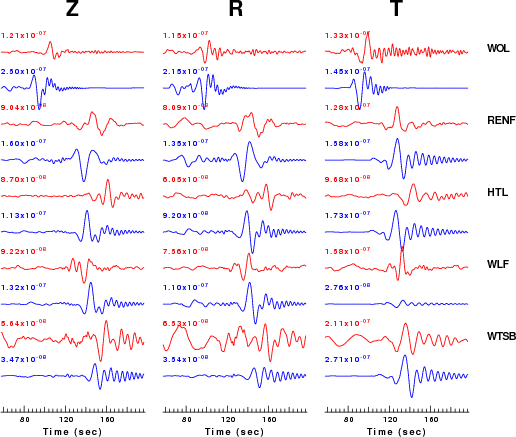
|
This figure shows the fit to the three components of motion (Z - vertical, R-radial and T - transverse). For each station and component, the observed traces is shown in red and the model predicted trace in blue. The traces represent filtered ground velocity in units of meters/sec (the peak value is printed adjacent to each trace; each pair of traces to plotted to the same scale to emphasize the difference in levels). Both synthetic and observed traces have been filtered using the SAC commands:
hp c 0.02 n 3 lp c 0.05 n 3

|

|
Should the national backbone of the USGS Advanced National Seismic System (ANSS) be implemented with an interstation separation of 300 km, it is very likely that an earthquake such as this would have been recorded at distances on the order of 100-200 km. This means that the closest station would have information on source depth and mechanism that was lacking here.
Dr. Harley Benz, USGS, provided the USGS USNSN digital data. The digital data used in this study were provided by Natural Resources Canada through their AUTODRM site http://www.seismo.nrcan.gc.ca/nwfa/autodrm/autodrm_req_e.php, and IRIS using their BUD interface
The figures below show the observed spectral amplitudes (units of cm-sec) at each station and the
theoretical predictions as a function of period for the mechanism given above. The modified Utah model earth model
was used to define the Green's functions. For each station, the Love and Rayleigh wave spectrail amplitudes are plotted with the same scaling so that one can get a sense fo the effects of the effects of the focal mechanism and depth on the excitation of each.
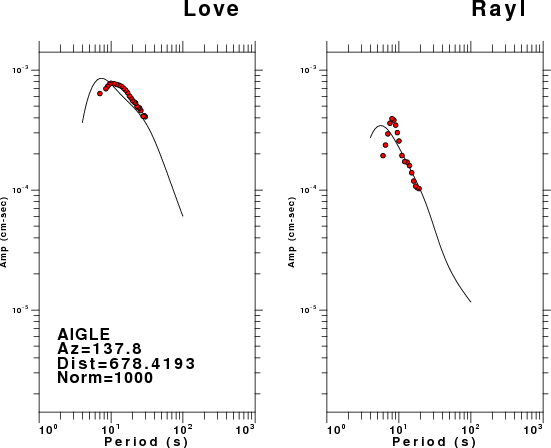 |
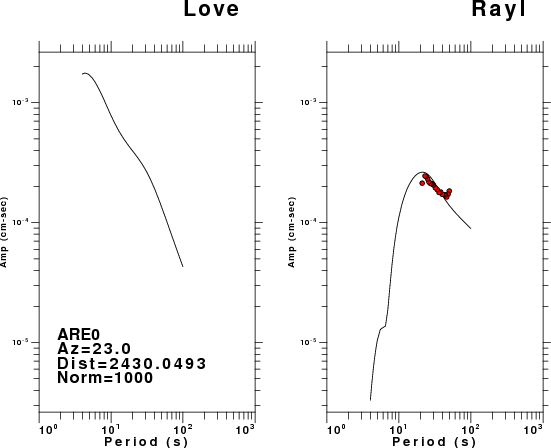 |
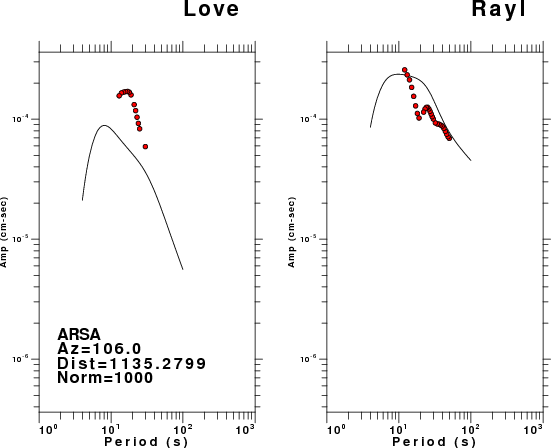 |
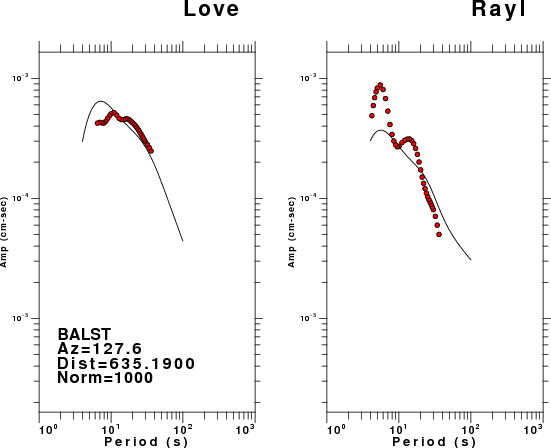 |
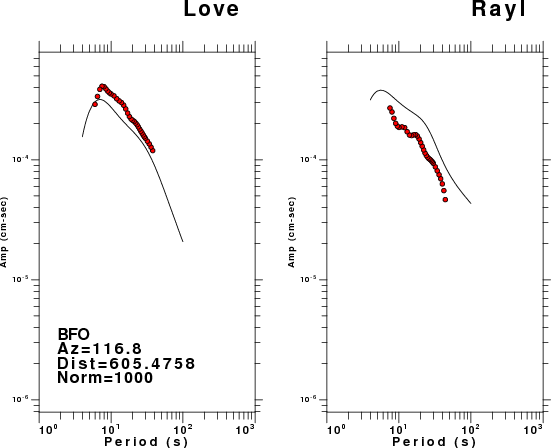 |
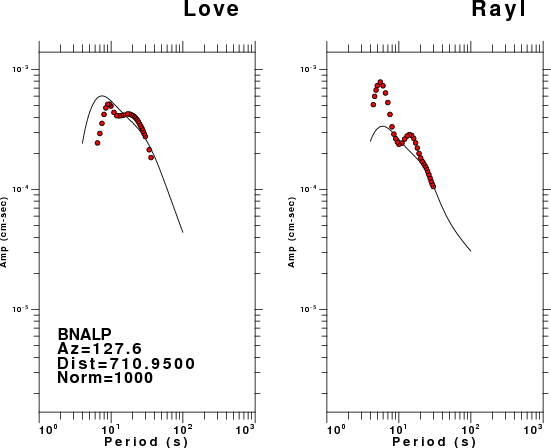 |
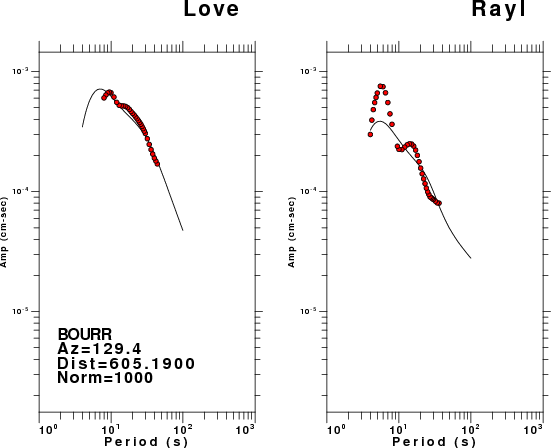 |
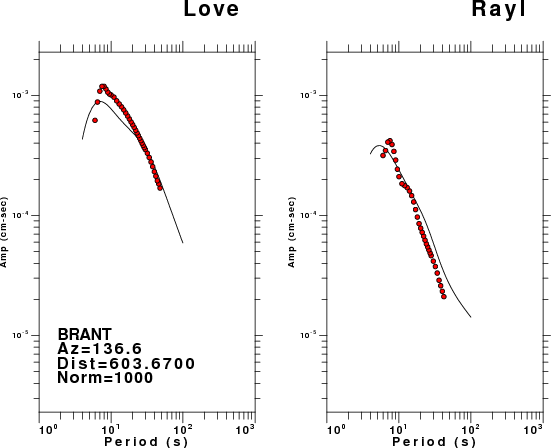 |
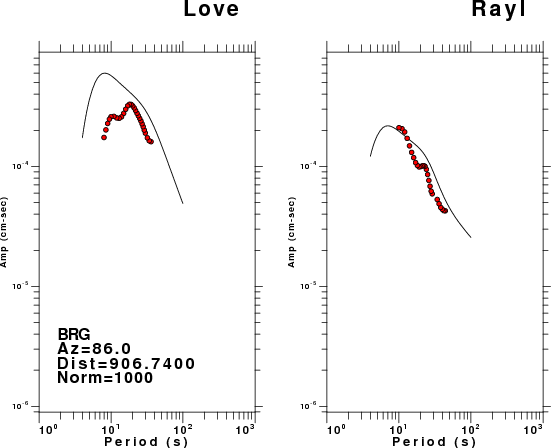 |
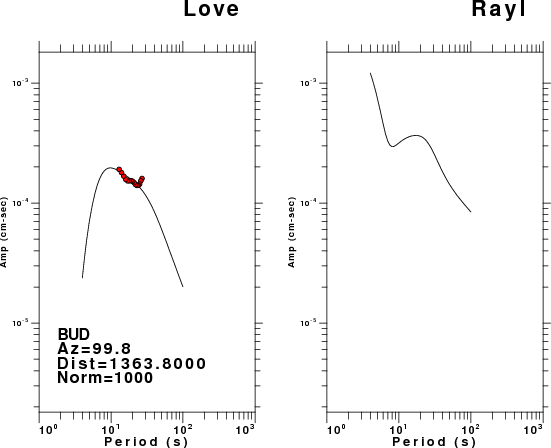 |
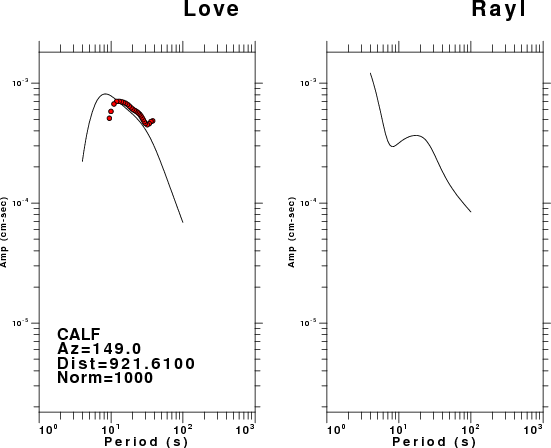 |
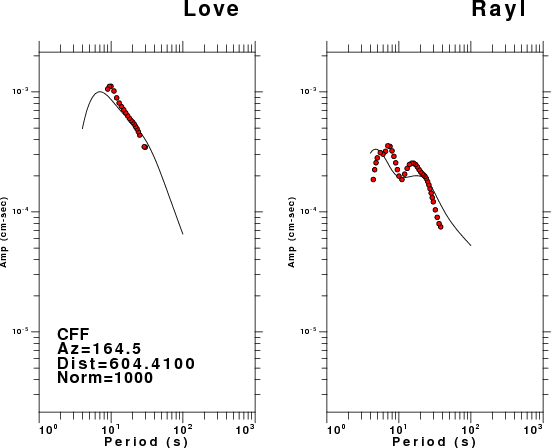 |
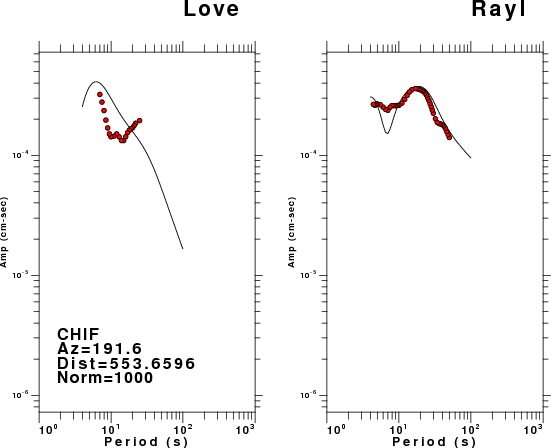 |
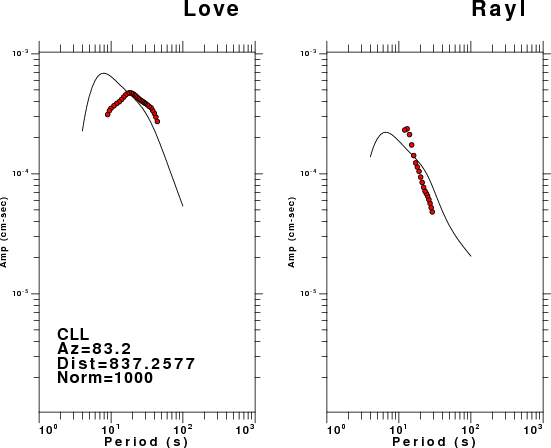 |
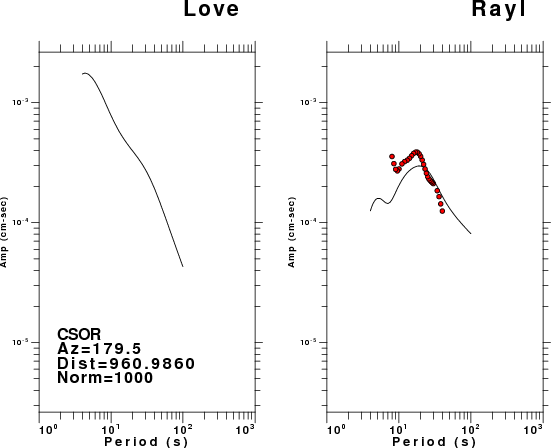 |
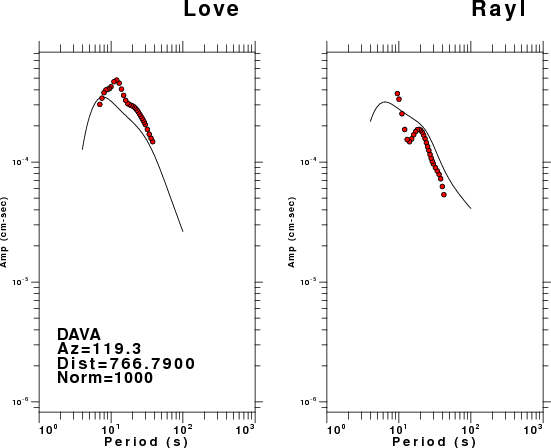 |
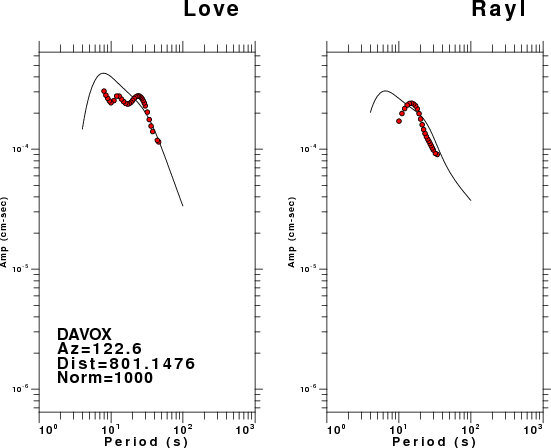 |
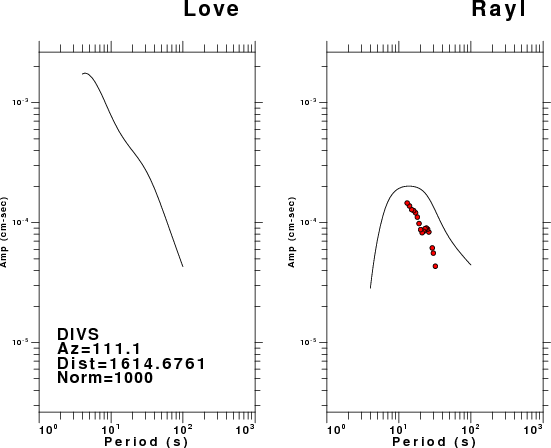 |
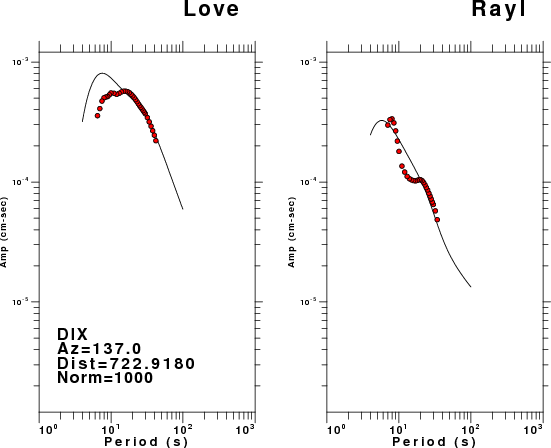 |
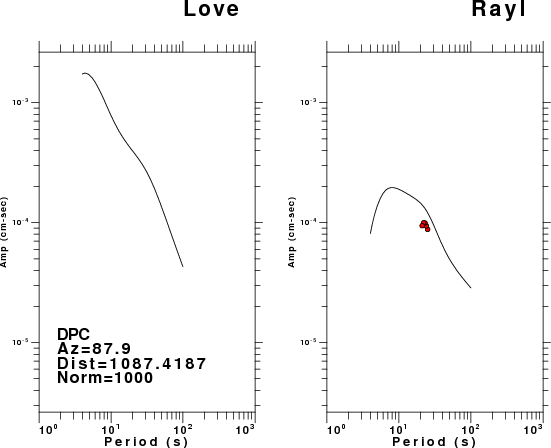 |
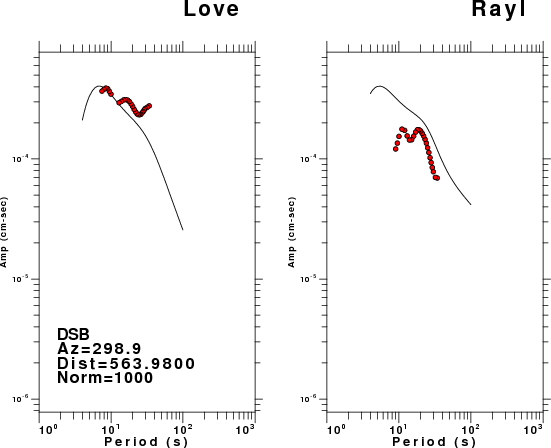 |
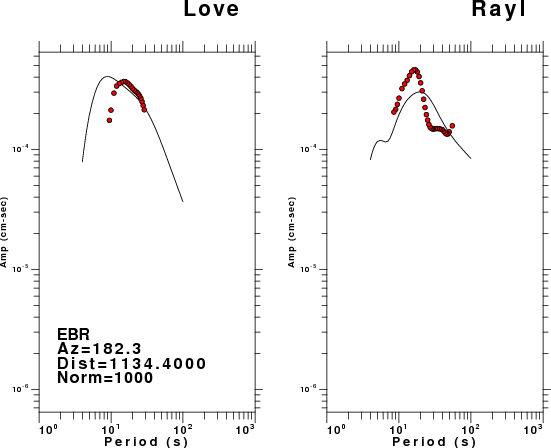 |
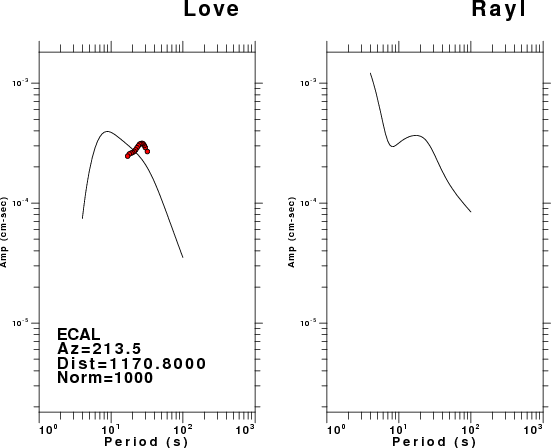 |
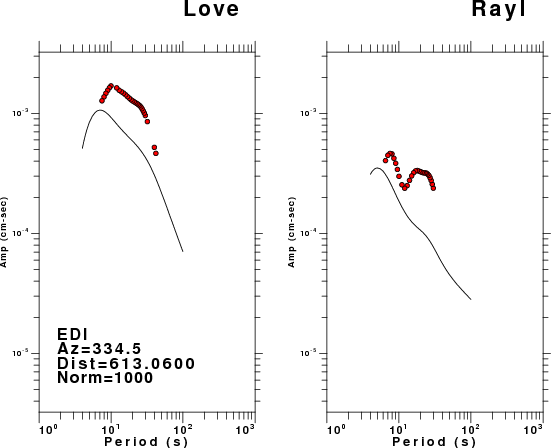 |
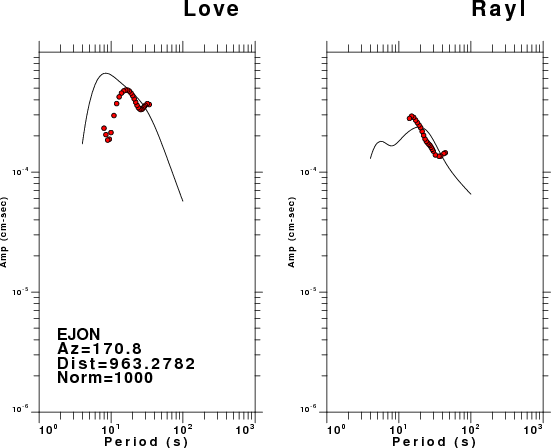 |
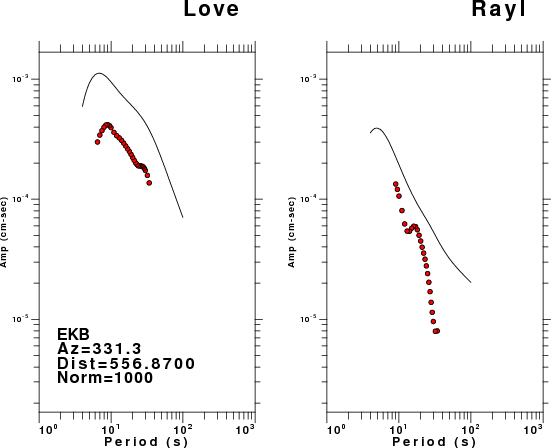 |
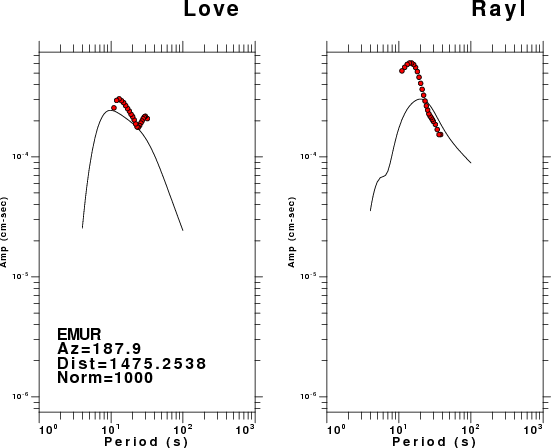 |
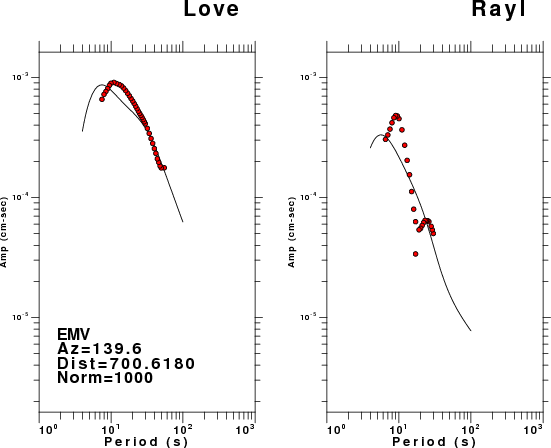 |
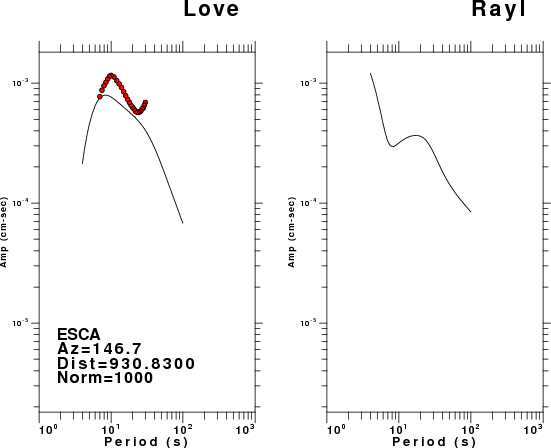 |
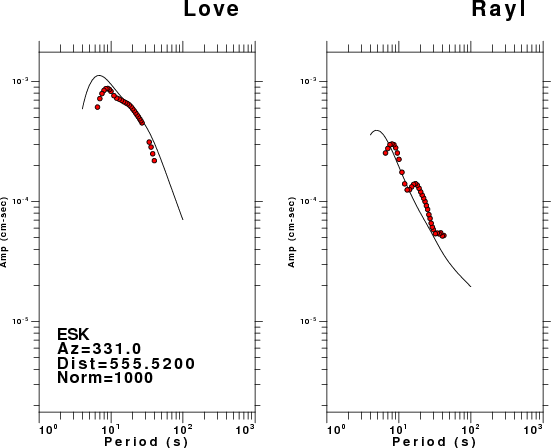 |
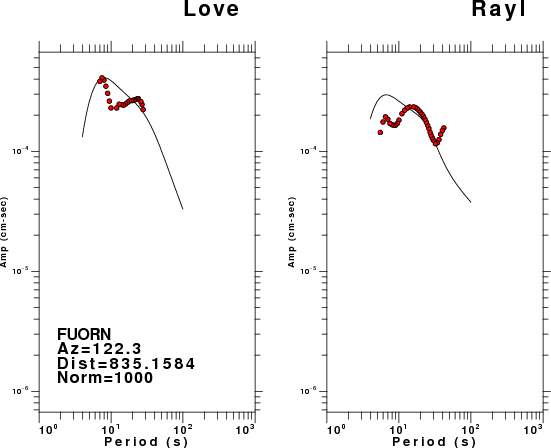 |
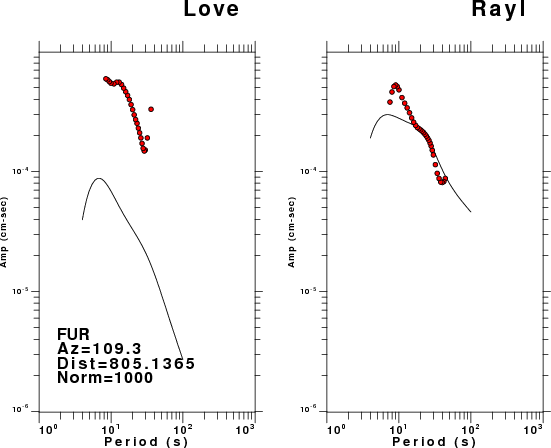 |
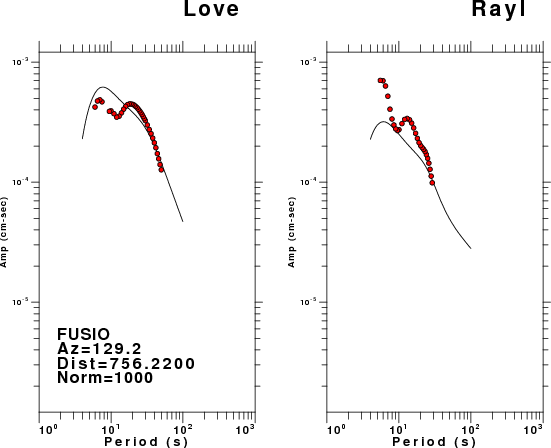 |
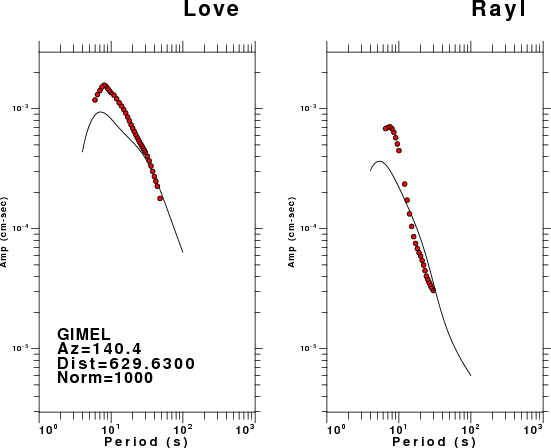 |
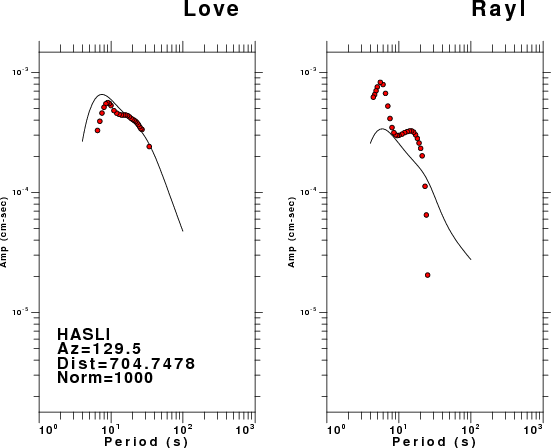 |
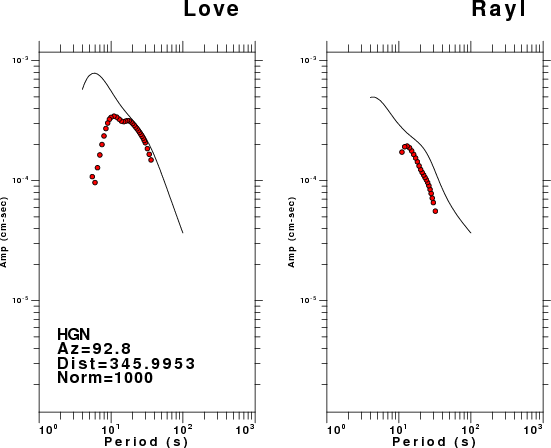 |
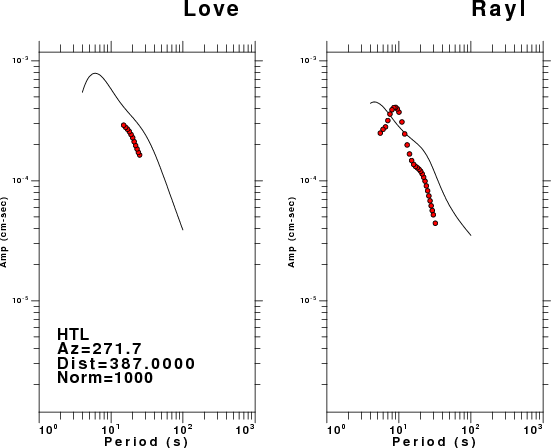 |
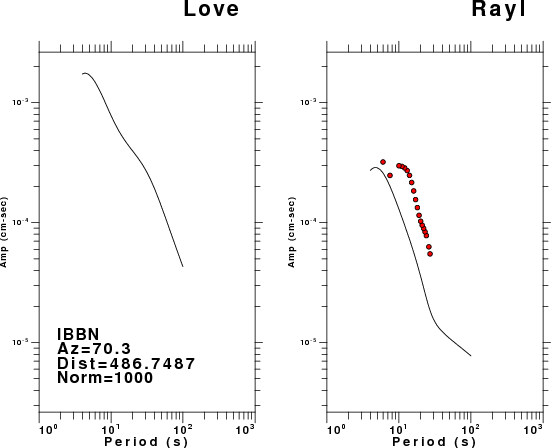 |
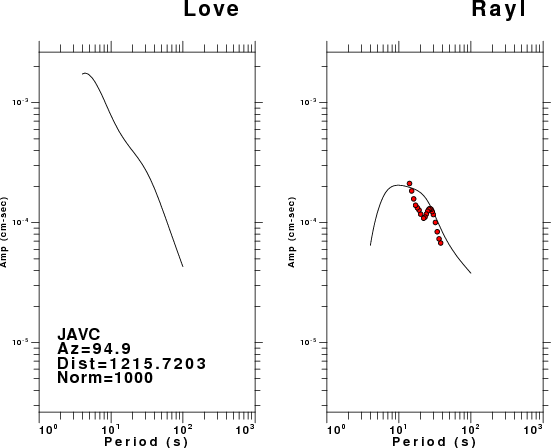 |
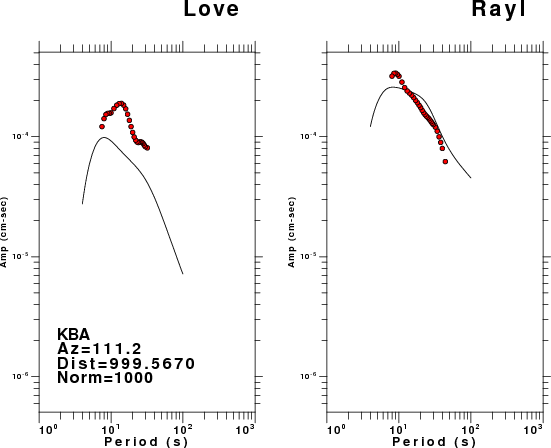 |
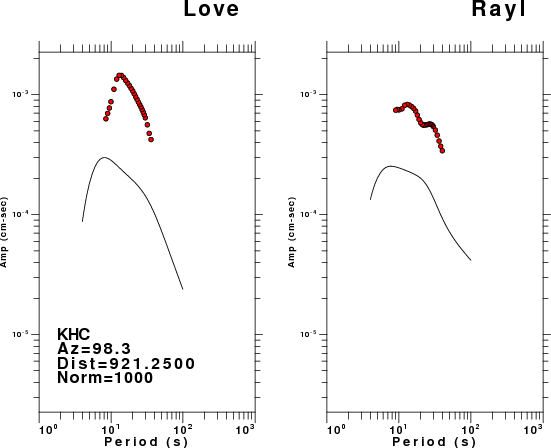 |
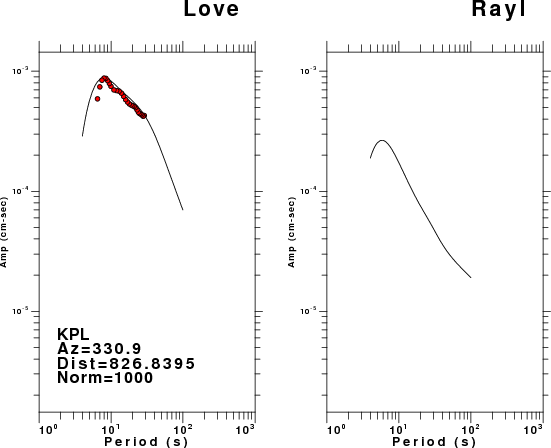 |
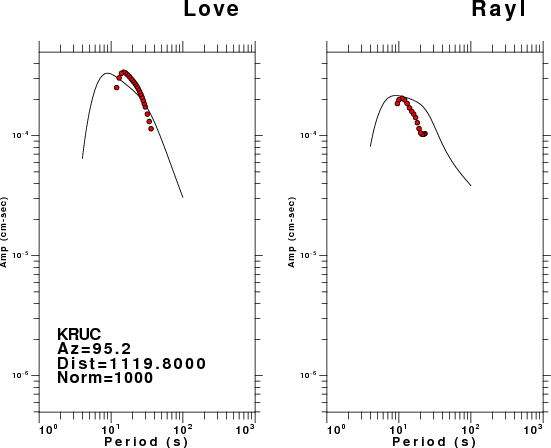 |
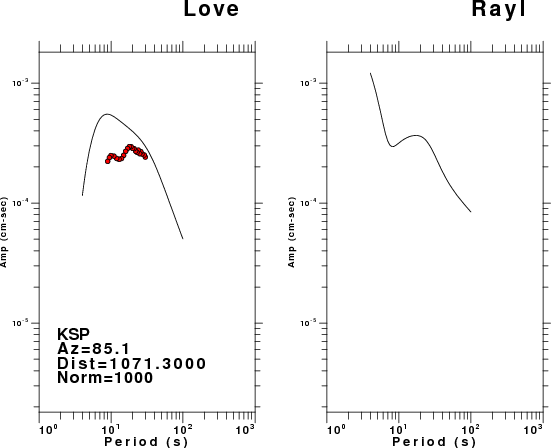 |
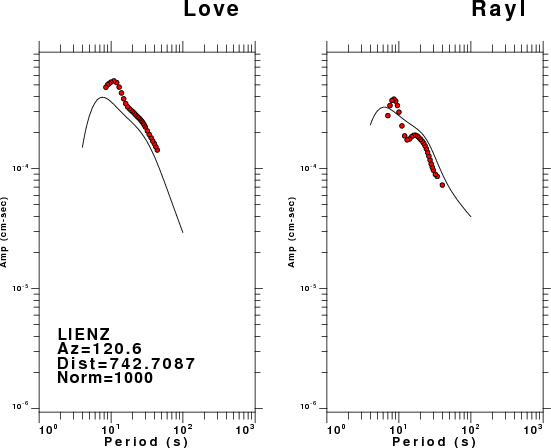 |
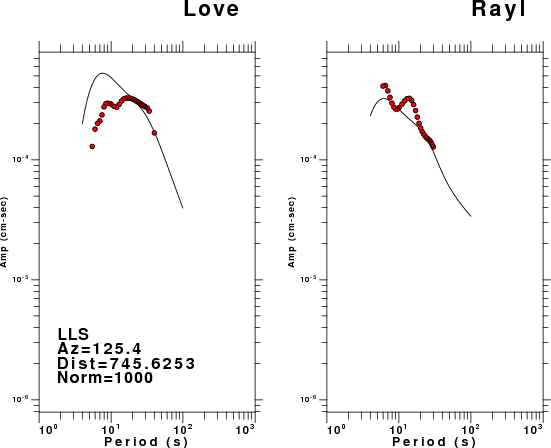 |
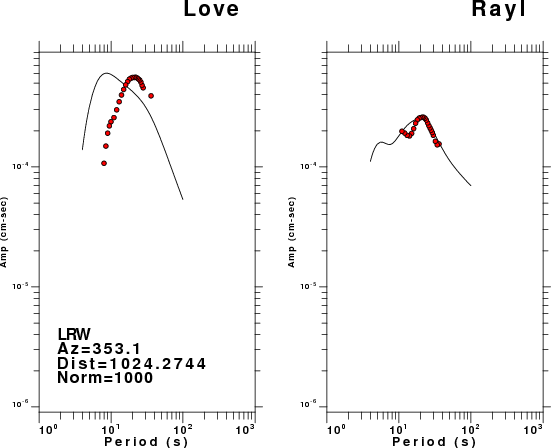 |
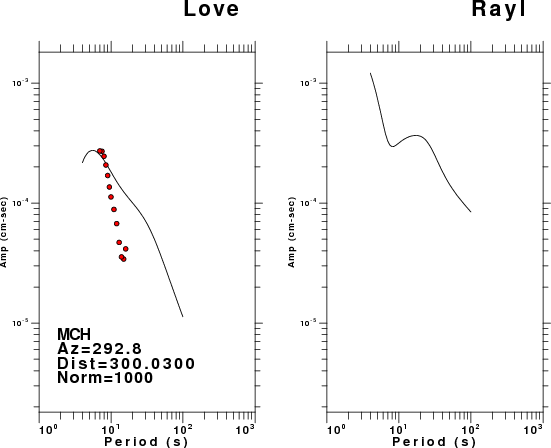 |
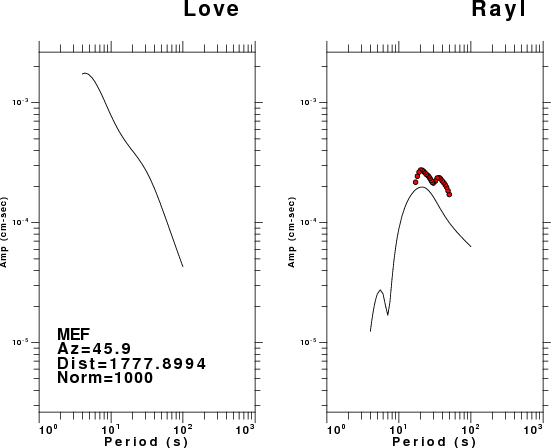 |
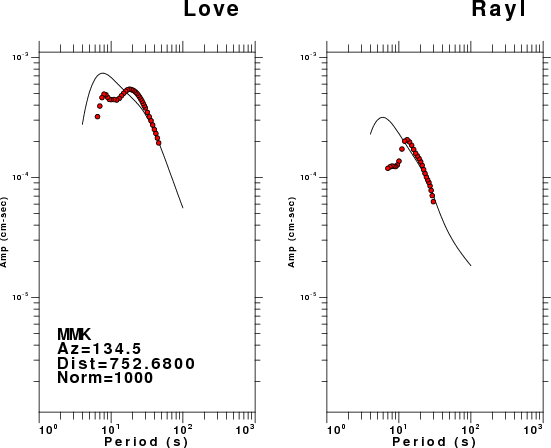 |
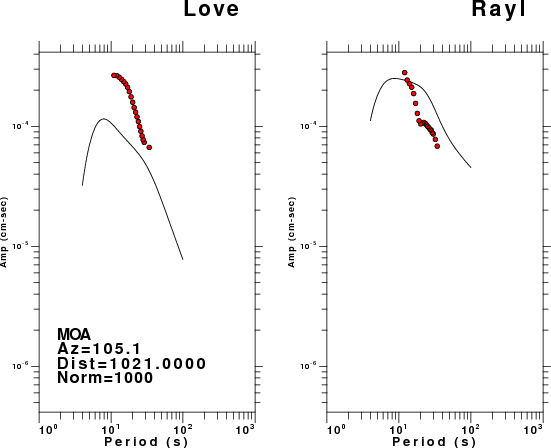 |
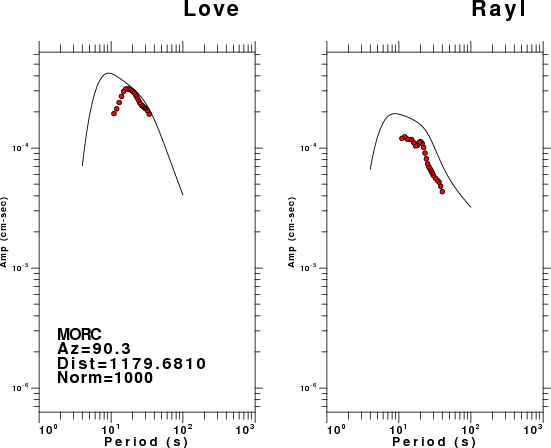 |
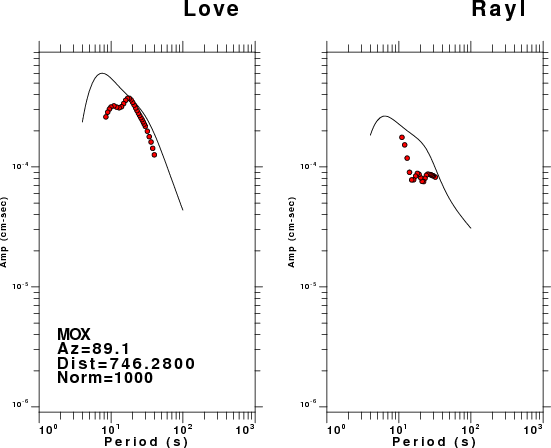 |
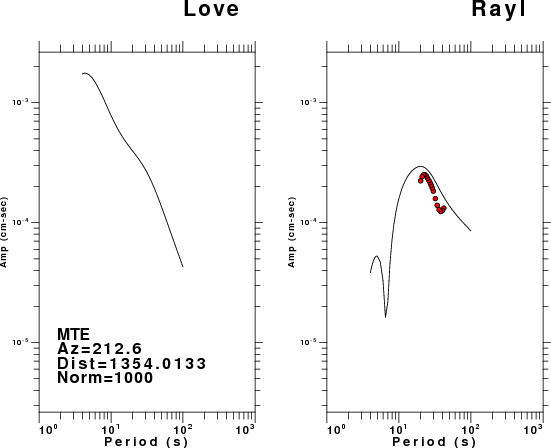 |
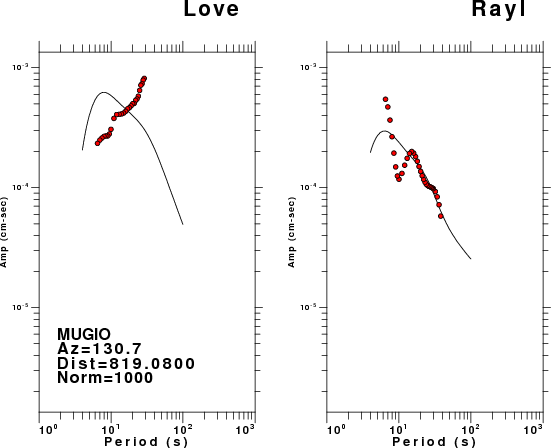 |
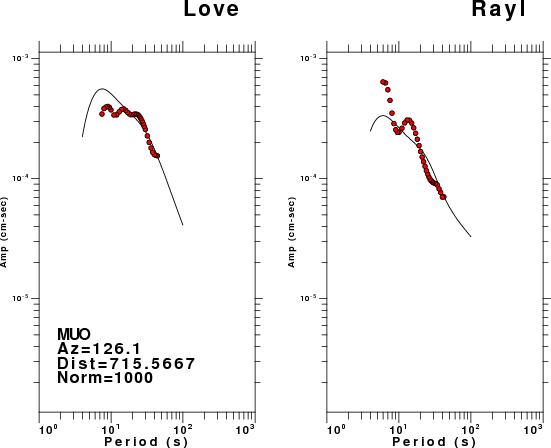 |
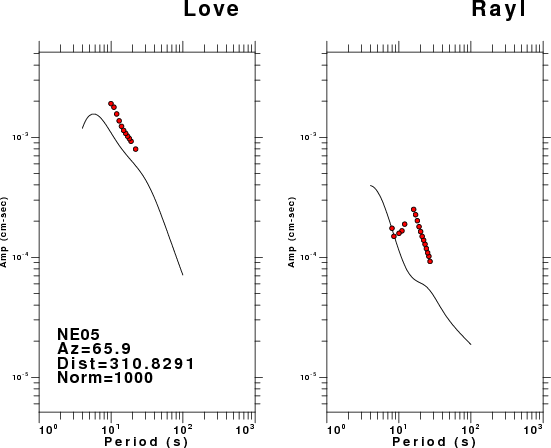 |
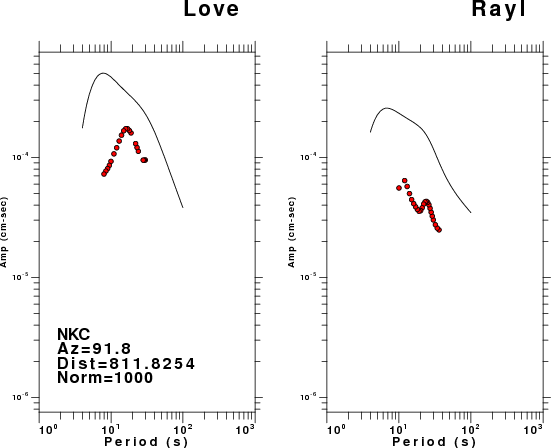 |
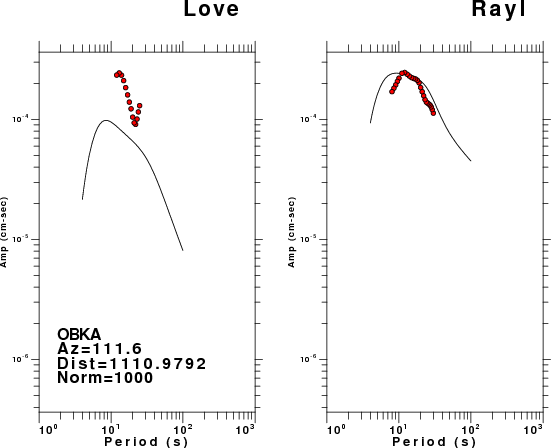 |
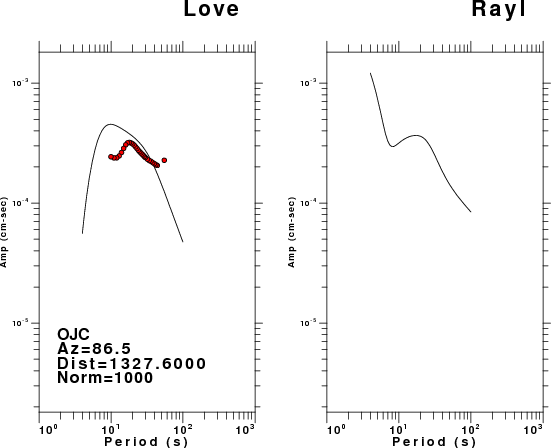 |
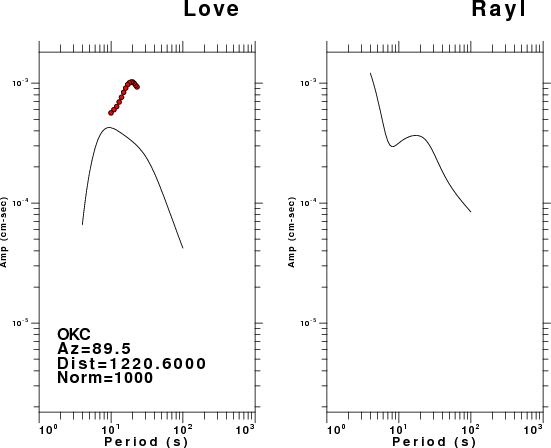 |
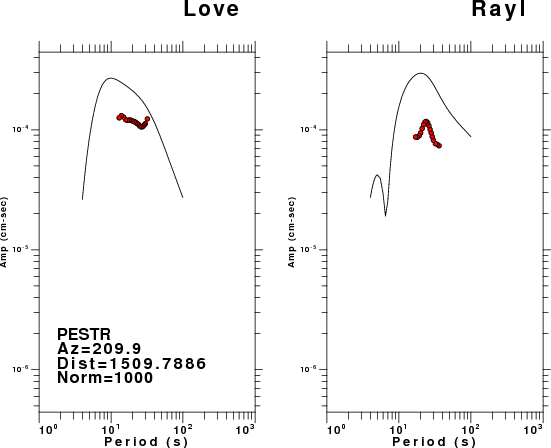 |
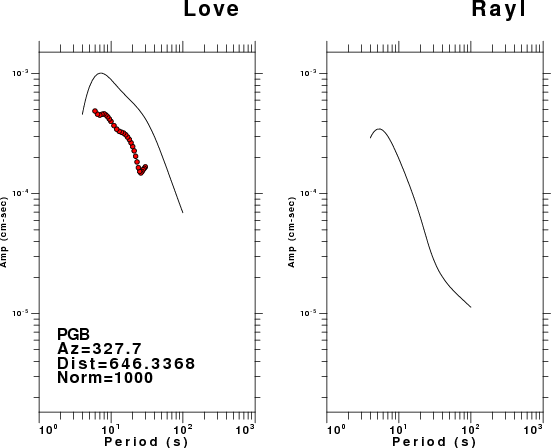 |
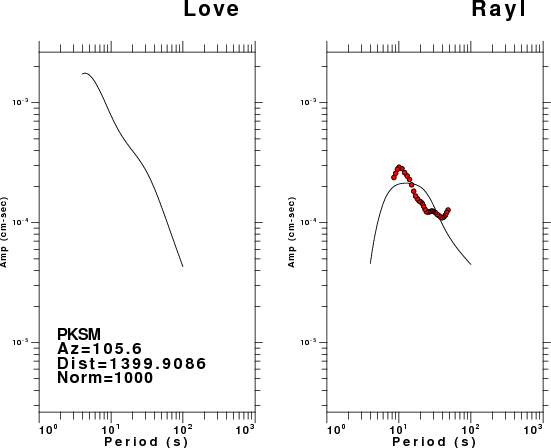 |
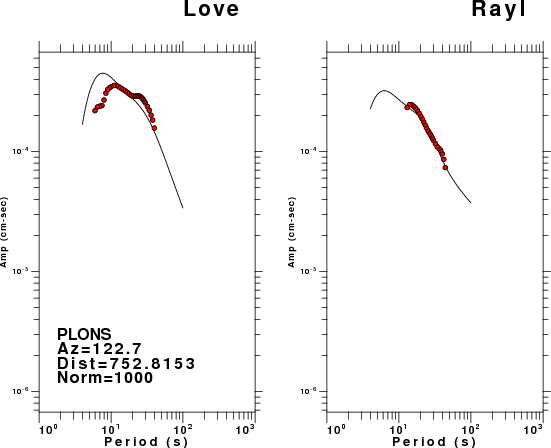 |
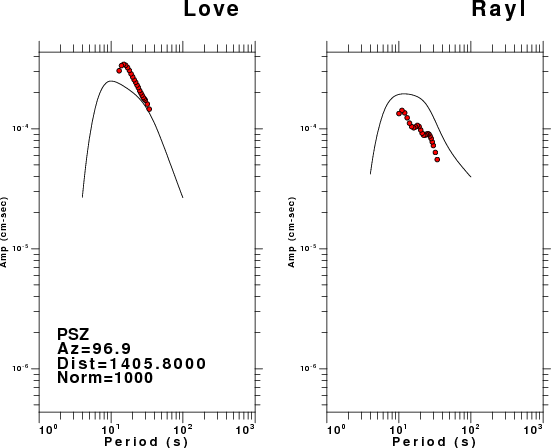 |
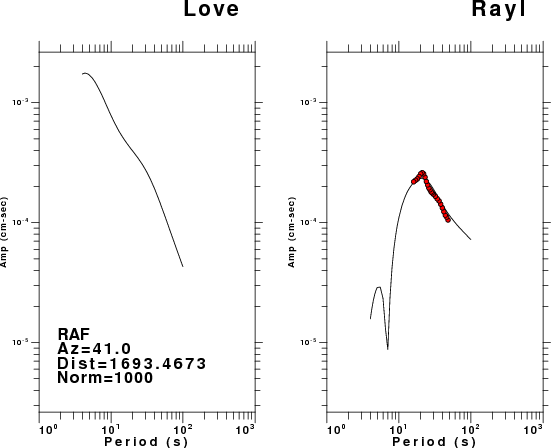 |
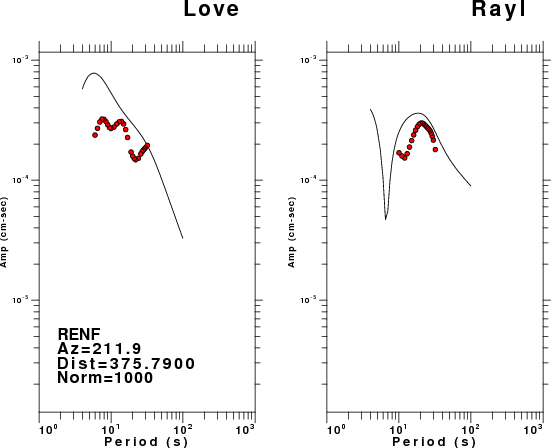 |
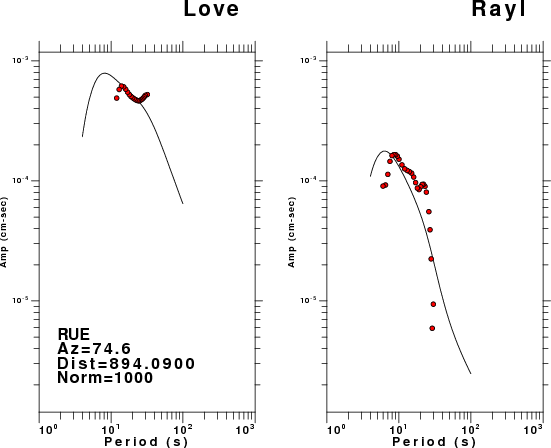 |
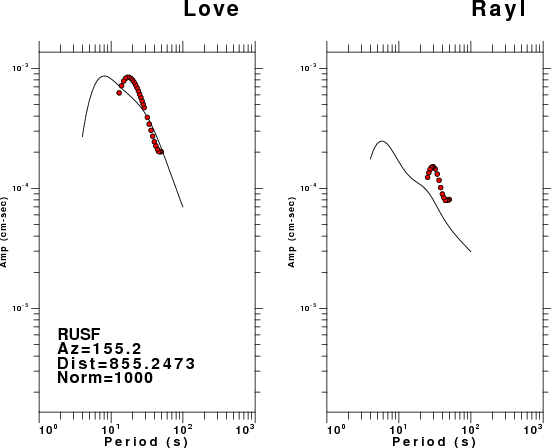 |
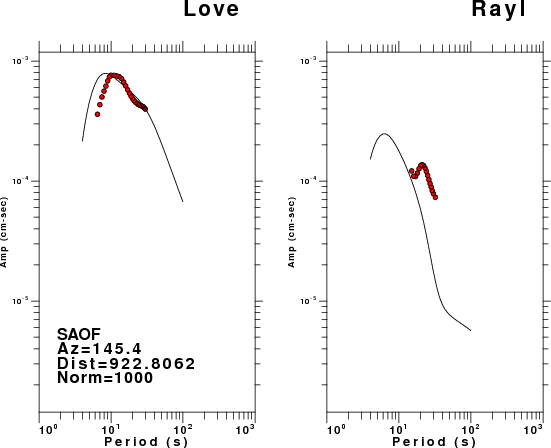 |
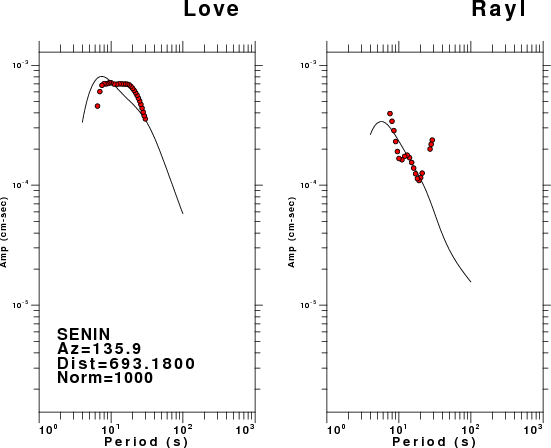 |
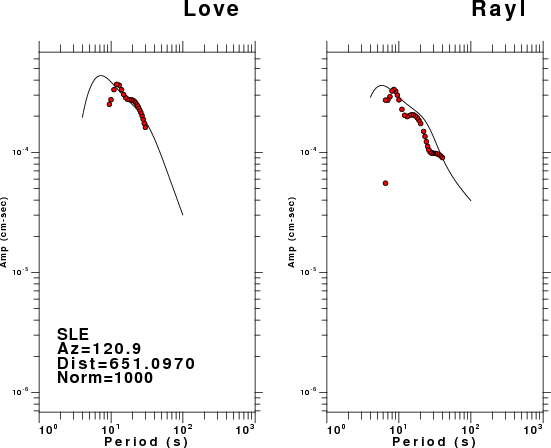 |
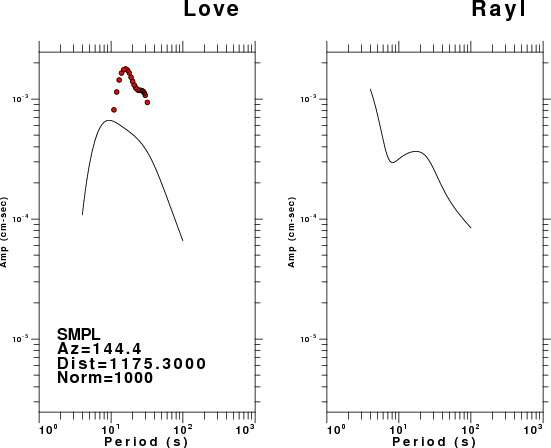 |
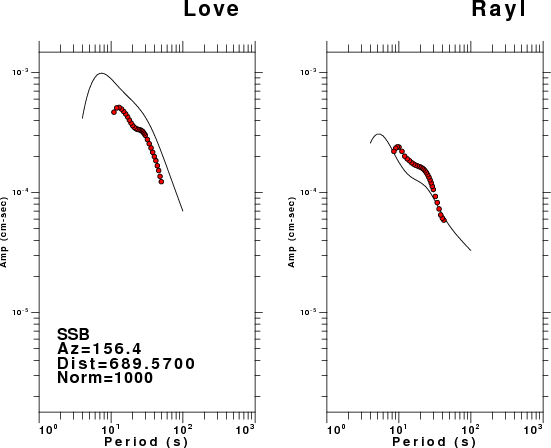 |
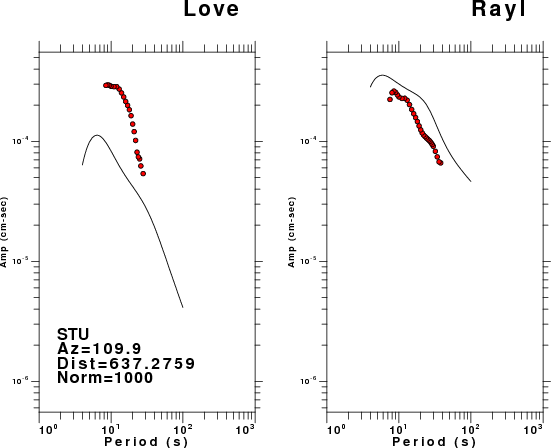 |
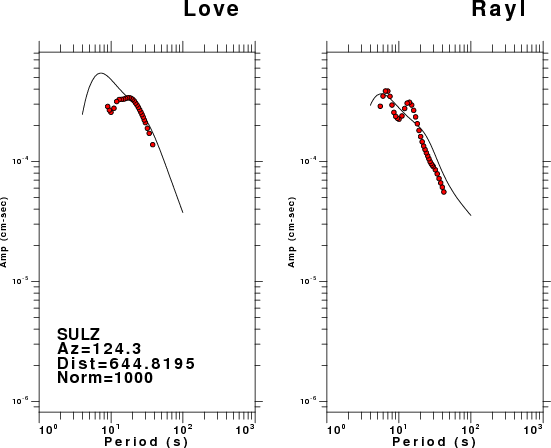 |
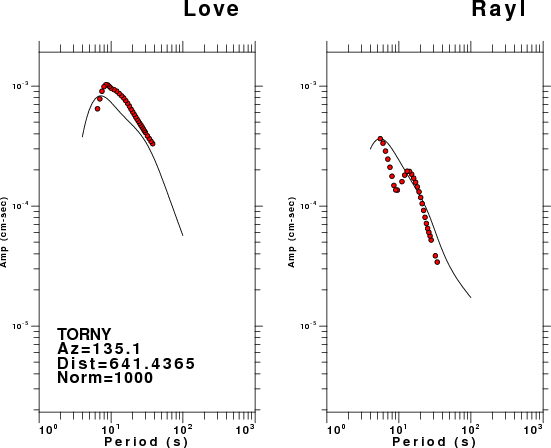 |
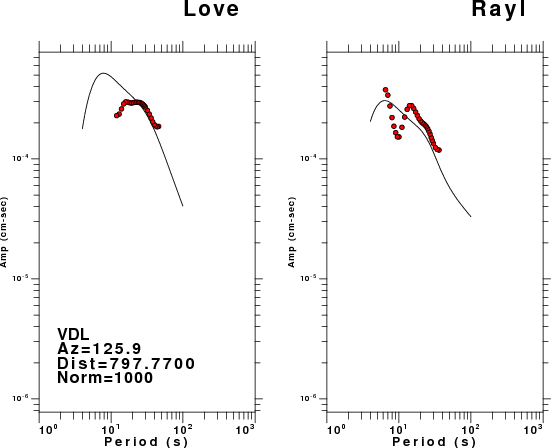 |
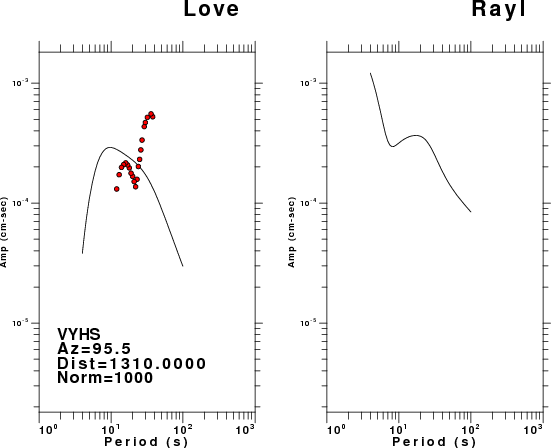 |
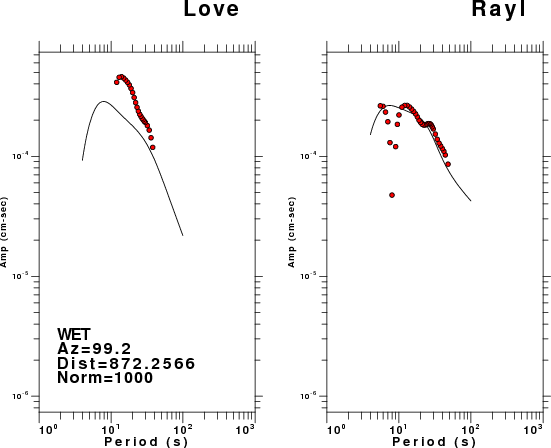 |
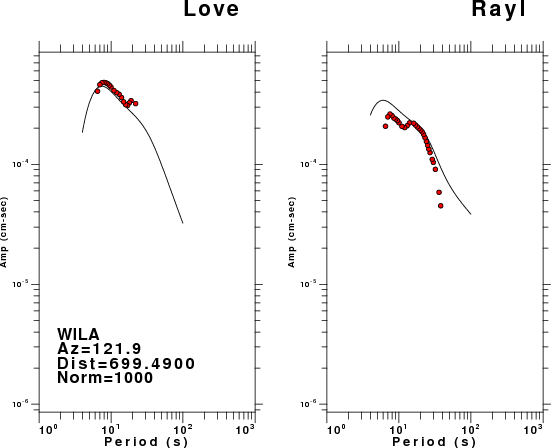 |
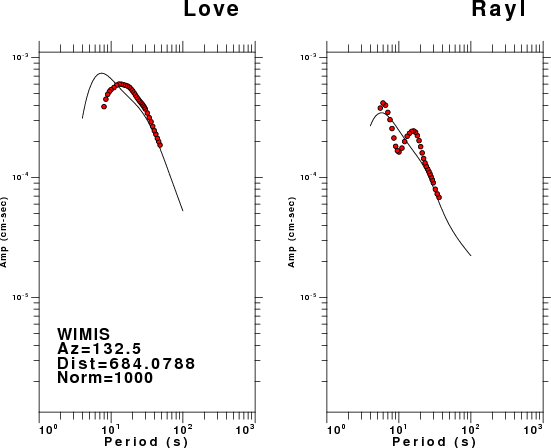 |
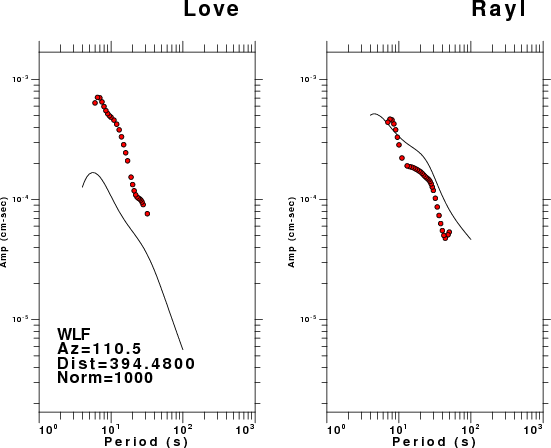 |
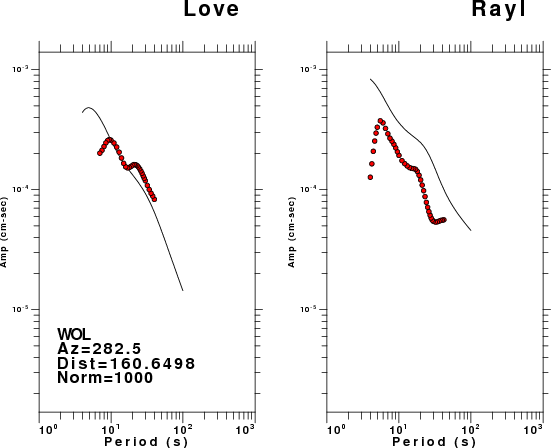 |
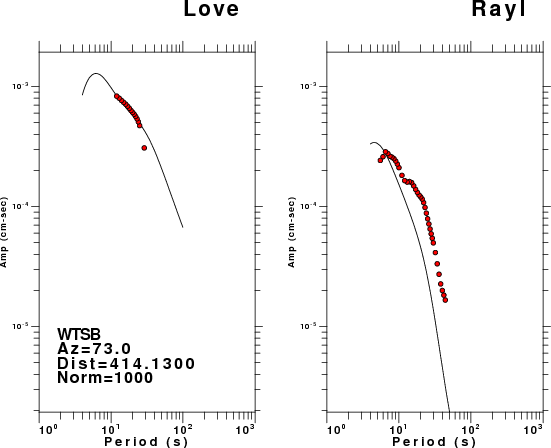 |
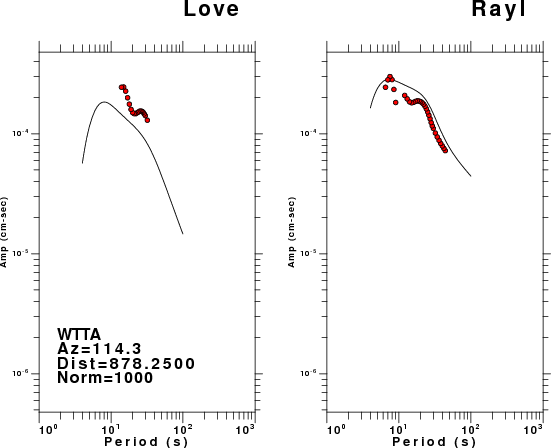 |
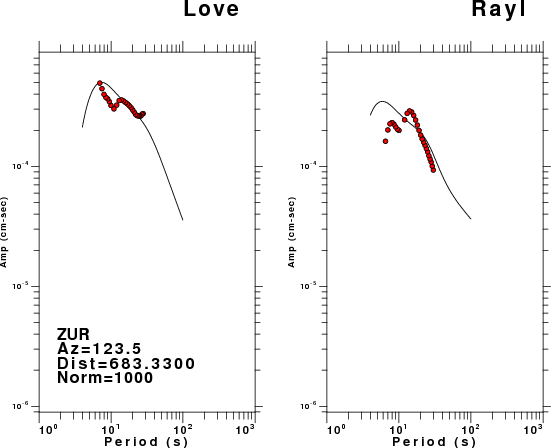 |
Here we tabulate the reasons for not using certain digital data sets
The following stations did not have a valid response files: